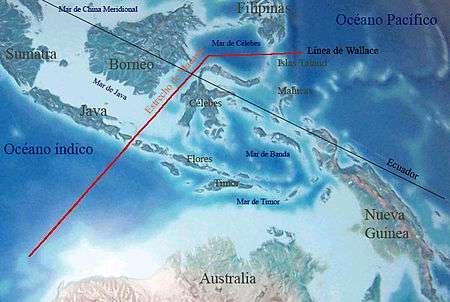Zoogeography

Zoogeography is the branch of the science of biogeography that is concerned with the geographic distribution (present and past) of animal species.[1]
Zoogeographic regions
Schmarda (1853) proposed 21 regions,[2][3] while Woodward proposed 27 terrestrial and 18 marine,[4] Murray (1866) proposed 4,[5] Blyth (1871) proposed 7,[6] Allen (1871) 8 regions,[7] Heilprin (1871) proposed 6,[8] Newton (1893) proposed 6,[9] Gadow (1893) proposed 4.[10]
Philip Sclater (1858) and Alfred Wallace (1876) identified the main zoogeographic regions of the world used today: Palaearctic, Aethiopian (today Afrotropic), Indian (today Indomalayan), Australasian, Nearctic and Neotropical.[11][12][13][14][15]
Marine regionalization began with Ortmann (1896).[16][17]
In a similar way to geobotanic divisions, our planet is divided in zoogeographical (or faunal) regions (further divided as provinces, territories and districts), sometimes including the categories Empire and Domain.
The current trend is to classify the floristic kingdoms of botany or zoogeographic regions of zoology as biogeographic realms.
Following, some examples of regionalizations:
- VI. Regio Neotropica
Huxley (1868)
Huxley (1868) scheme:[18]
- Arctogea
- Nearctic province
- Palaearctic province
- Ethiopian province
- Indian province
- Notogea
- Austro-Columbia province (= Neotropical)
- Australasia province (= Australian; Eastern Palaeotropical)
Wallace (1876)
- Palaearctic region
- Ethiopian region
- Oriental region
- Australaian region
- Neotropical region
- Nearctic region
Darlington (1957)
First scheme:
- Realm Megagea (Arctogea): the main part of the world
- 1. Ethiopian Region: Africa (except the northern corner), with part of southern Arabia
- 2. Oriental Region: tropical Asia, with associated continental islands
- 3. Palearctic Region: Eurasia above the tropics, with the northern corner of Africa
- 4. Nearctic Region: North America, excepting the tropical part of Mexico
- Realm Neogea
- 5. Neotropical Region: South and Central America with the tropical part of Mexico
- Realm Notogea
- 6. Australian Region: Australia, with New Guinea, etc.
Second scheme:
- Climate-limited regions
- 1. Palearctic Region
- 2. Nearctic Region
- Main regions of the Old World tropics
- 3. Oriental Region
- 4. Ethiopian Region
- Barrier-limited regions
- 5. Neotropical Region
- 6. Australian Region
See also
References
- ↑ Darlington, P.J., Jr. 1957. Zoogeography: The Geographical Distribution of Animals. New York, .
- ↑ Schmarda L. K. 1853. Die geographische Verbreitung der Tiere. Wien, Gerold und Sohn, .
- ↑ Ebach, M.C. (2015). Origins of biogeography. The role of biological classification in early plant and animal geography. Dordrecht: Springer, xiv + 173 pp., .
- ↑ Woodward, Samuel Pickworth. A Manual of the Mollusca; or a Rudimentary Treatise of Recent and Fossil Shells. 3 parts. London, 1851-56, .
- ↑ Murray, A. 1866. The Geographical Distribution of Mammals. London: Day and Son, .
- ↑ Blith, E. (1871): A suggested new division of the earth into zoological regions. Nature 3: 427
- ↑ Allen, J. A. 1871. On the mammals and winter birds of East Florida. Bulletin of the Museum of Comparative Zoology 2:161–450.
- ↑ Heilprin, A. 1887. The geographical and geological distribution of animals. New York: Appleton, .
- ↑ Newton, A. (1893). Article on Geographical Distribution in the Dictionary of Birds, p. 311. London, .
- ↑ Gadow, H. 1893. Vögel. II. Systematischer Theil. In H. G. Bronn (ed.), Klassen und Ordnungen des Thier-Reichs, vol. 6. Leipzig: C. F. Winter, .
- ↑ Sclater, P.L. (1858). On the general geographical distribution of the members of the class Aves. J. Proc. Linnean Soc. Zool. 2: 130–145, .
- ↑ Wallace A.R. 1876. The geographical distribution of animals. Macmillan, London, .
- ↑ Cox, C. B. (2001). The biogeographic regions reconsidered. Journal of Biogeography, 28: 511-523, .
- ↑ Holt, B. G., et al. (2013). An update of Wallace’s zoogeographic regions of the world. Science, vol. 339, no. 6115, pp. 74-78.
- ↑ Cox, C. B., Moore, P.D. & Ladle, R. J. 2016. Biogeography: an ecological and evolutionary approach. 9th edition. John Wiley & Sons: Hoboken, p. 12, .
- ↑ Ortmann, A.E. (1896). Grundzüge der marinen Tiergeographie. Jena: Gustav Fischer, .
- ↑ Morrone, J. J. (2009). Evolutionary biogeography, an integrative approach with case studies. Columbia University Press, New York, .
- ↑ Huxley, T.H. 1868. On the classification and distribution of the Alectoromorphae and Heteromorpha. Proceedings of the Zoological Society of London 1868: 294-319, .
Bibliography
External links
| Wikimedia Commons has media related to Zoogeography. |




